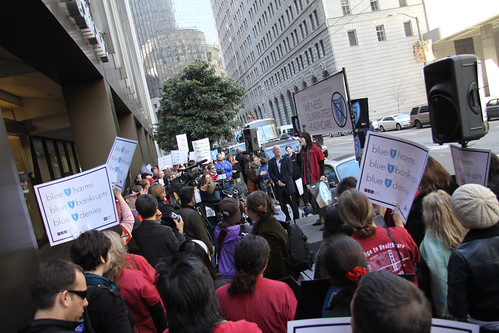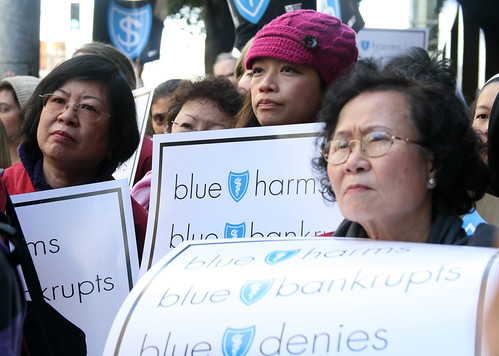For anyone not interested in slogging through the debate on the 500-odd amendments to the Baucus bill, it has become increasingly and painfully apparent that the healthcare legislation soon to emerge from at least the Senate will fall far short in reigning in out of control health care costs.
That lapse is especially ironic in that “affordability” is perhaps the only goal that seems to top everyone’s to do list, from President Obama to the “keep the government hands off my (government-financed) Medicare” crowd.
But as long as our policy makers refuse to throw the elephant out of the room, the insurance company pirates and their predatory pricing practices, all their subsidies and tweaking will amount to little more than an umbrella in a hurricane.
First some ugly reminders as to why this is such a critical issue.
Annual family premiums now average $13,375. If current trends continue, by some accounts the average family plan is expected to hit $30,083 in just 10 years.
Over the past decade, premiums have increased by 138 percent, about three and a half times greater than inflation or incomes.
That, of course is just premiums. Most people now also have unsightly co-pays on office visits and other transactions, deductibles you must pay before your insurance pays anything, and co-insurance, such as a 20 percent charge on lab tests, outpatient procedures, and other medical services.
Those fees are especially large in high deductible plans, increasingly pushed by employers who face their own financial woes with rising premiums, and families juggling mortgage, food, and health insurance costs. Average deductibles for employer-sponsored high deductible plans were $1,973 for individuals and $3,883 for family policies in 2007.
Add it all up, and the results are tragic, if not predictable.
* The number of uninsured is up to 46 million; millions more are under-insured (people with limited plans that leave them vulnerable in the event of unexpected health emergencies).
* More employers are shifting costs to employees, or dropping coverage entirely.
* Medical bills are now the principle factor in 62 percent of personal bankruptcies.
* More than half of Americans, the majority of them people with insurance, are skipping needed care due to high out-of-pocket costs.
* Business is booming in emergency rooms for those who forgo needed primary care, increasing overall healthcare costs, not to mention the added pain and suffering.
A few examples of the self-rationing. The Los Angeles Times reported in April, mammography screenings among women in the vulnerable age group of 50-64 have declined 7 percent and dental business in Southern California is down 15 to 30 percent. The New York Times reported in March a drop in elective surgeries of nearly 50 percent in New Jersey and Georgia, and a drop in cataract surgeries of 5 percent in Ohio.
With their super majority now restored in the Senate, following the appointment today in Massachusetts, and a similar margin in the House, the Obama administration and Congress could have taken the strongest step to reverse these disastrous trends.
By eliminating the middle man role of the private insurance industry (as they are proposing to do with banks and student loans), and the insurers built-in incentive to continually raise prices and fees to increase profits and waste up to 30 cents of every healthcare dollar, much of it on paperwork to avoid paying claims for care that cut into those profits.
But, since our elected leaders decided not to pursue the most effective and efficient way to control costs through a single-payer system such as expanding Medicare to cover everyone, they have had to come up with some other convoluted and far less effective approaches, and ones with some ominous consequences.
1. Individual mandate.
Everyone not presently covered will be required to buy insurance under the dubious theory that giving the insurers a larger risk pool in which everyone has a health policy, the insurers will no longer have to continually raise premiums to cover the costs for the uninsured.
That assumes insurers will act conscientiously to limit price gouging. They won’t; in fact, under federal law, for-profit insurance companies have a fiduciary obligation to maximize profits for their shareholders.
While mandating everyone to buy insurance, Congress and the administration are not mandating insurers to stop price gouging or proposing price controls. To see how that will turn out, look at Massachusetts today, which has the model for this idea.
In Massachusetts, the number of uninsured is again rising, after it initially fell when the law was passed, as more people are opting to pay the penalty rather than pay the rising premiums they can’t afford. Some 42 percent of those buying policies through the state exchange (the same model proposed by Congress and Obama) are choosing plans with higher cost sharing requirements.
Moreover, Massachusetts lets insurers charge the 50 somethings, the pre-Medicare age group, more than younger people, with the result that demographic is gobbling up the bare bones, least comprehensive coverage just when they need medical care more; the Congressional bills repeat this disastrous flaw. Baucus initially wanted to let insurers charge this age bracket five times more, but has since relented and reduced it to four times more.
Further, without effective cost controls, Massachusetts has found the subsidies for low and moderate income are bankrupting the budget. To adjust, they have reduced covered services and groups eligible people, such as legal immigrants (for anyone who thinks the right wing will be satisfied with just eliminating coverage for the undocumented).
In sum, the entire individual mandate scam is a huge windfall for the insurance industry, tens of millions of new customers forced by the government to buy private policies, and public subsidies for some sub-section of the moderate income, another government bailout to a big industry.
Though a final bill is expected to include caps on what people will be expected to pay in out-of-pocket costs, and exemptions in co-pays for preventive care, both laudable ideas, the failure to stop the insurers pricing practices on the front end spells long term trouble, and probably failure for the “affordability” of the mandated insurance.
2. Taxing “Cadillac” plans.
A centerpiece of the Baucus bill, taxing more expensive health policies under the again questionable thesis that a- insurers will lower overall charges if not selling policies that offer more coverage (who thought that up, Sponge Bob?) and b- patients will be more selective in seeking supposedly unnecessary medical care when they have cheaper plans that force them to spend more out of pocket.
Some in the media have already done a good job deconstructing this fiasco.
Columbia Journalism Review’s Trudy Lieberman noted that more workers will have “less coverage for medical care which will mean they could be underinsured when serious illness strikes” and the looming prospect of medical bankruptcy “when the stack of bills gets too high.”
Some, and not just the nutters at Fox News, aren’t apparently troubled by this. Rightwing policy wonks have long cited over utilization of medical care as the reason why health costs are so much higher in the U.S. than anywhere else in the world, as if we can’t wait for those colonoscopies and dental work and so abuse our “gold plated” insurance plans to get them more often.
Far too many liberals and progressives are in this camp as well, missing the point which is not to shift costs around but to actually control them.
Reed Abelson of the New York Times pointed out another major flaw. The tax penalizes small employers who she noted:
“tend to pay more for their insurance than bigger employers that can negotiate better premiums. And because they do not have large pools of workers to help spread the risk, small employers tend to pay even higher amounts if they have older or sicker workers.”
Additionally, without strong price controls, premiums will continue to rise, pushing the cost of more plans every year into the bracket that will be taxed. The labor movement has, to their credit, understood the many flaws with this scam and led the attacks on it.
3. A variety of gimmicks to stop the dreaded overutilization and reduce costs through comparable research, information technology, best practices, and other lingo.
Some technology promotes better care when it complements and assists the work of care delivery, not replace it. A lot of it doesn’t. What has yet to be proven is that it is effective in substantially reducing overall healthcare costs.
Would enactment of a robust public option be sufficient to address all these myriad shortcomings? Perhaps. But not if all its levers, such as the ability to negotiate lower rates or open its doors to all comers, are stripped out, as several proposals do.
In any event, the larger question is will the reforms now proposed actually solve this healthcare crisis, even on the critical issue of cost? Four years from now, our policy makers, and those who say pass a bill no matter what it contains can’t say they haven’t been told.




